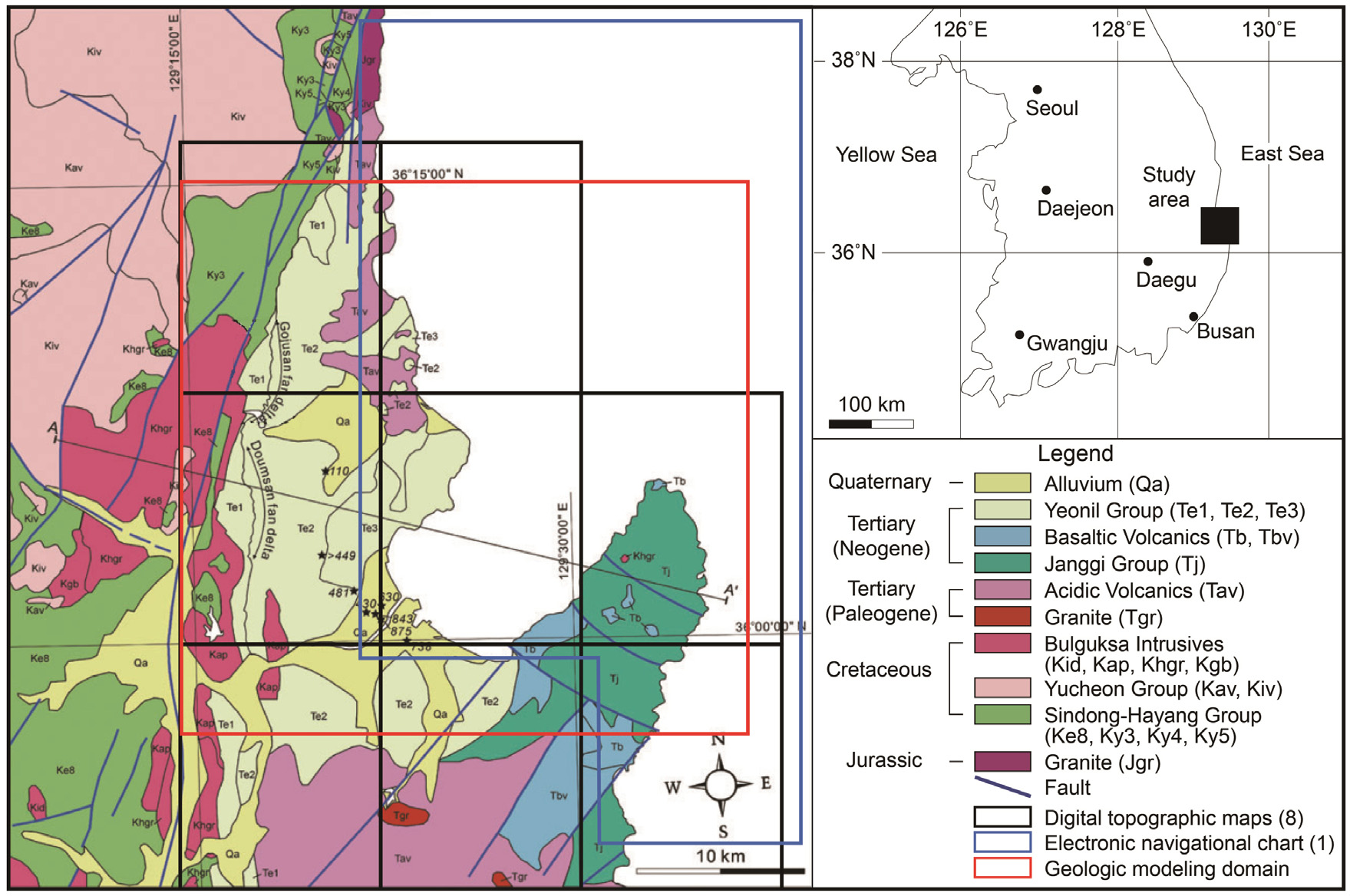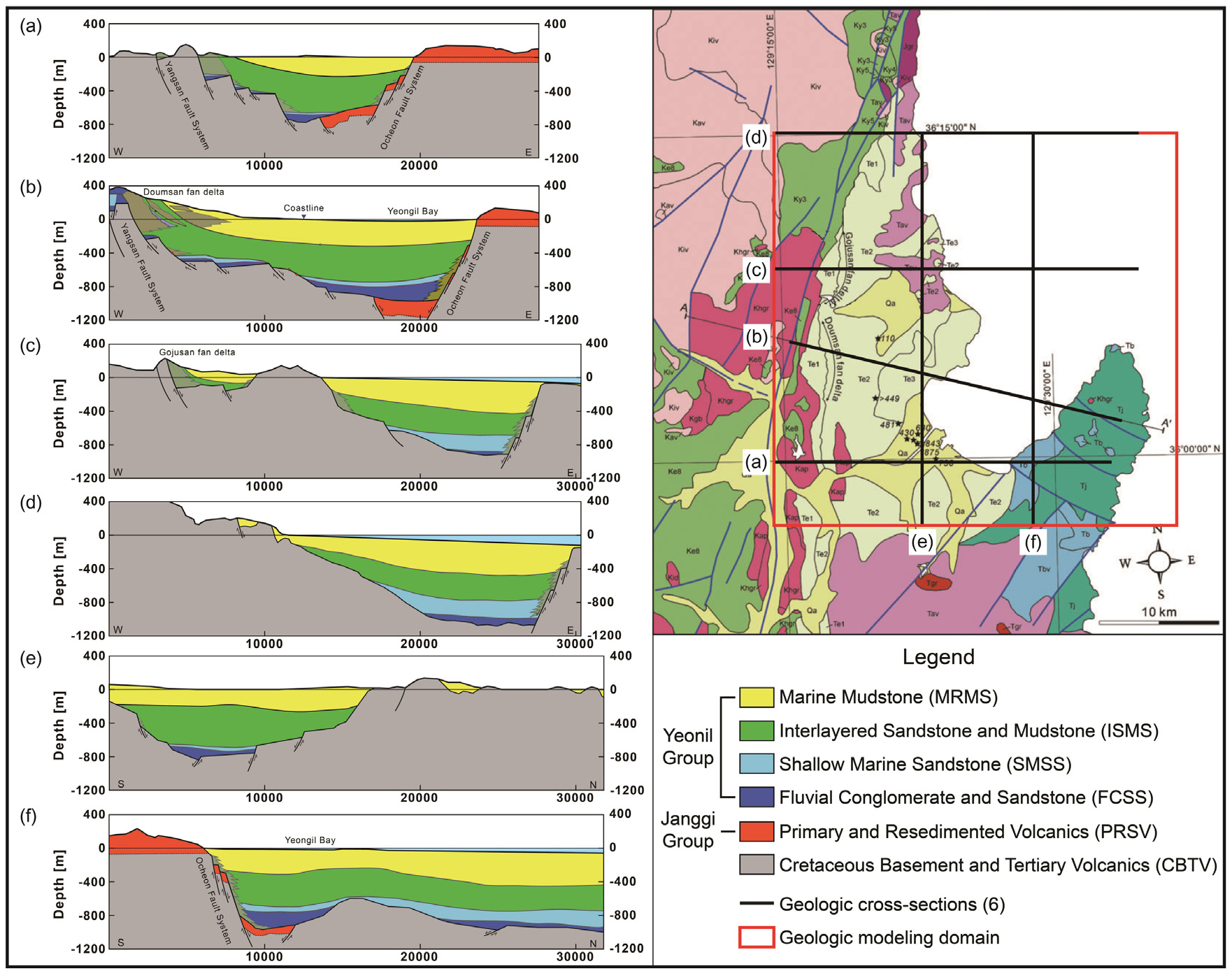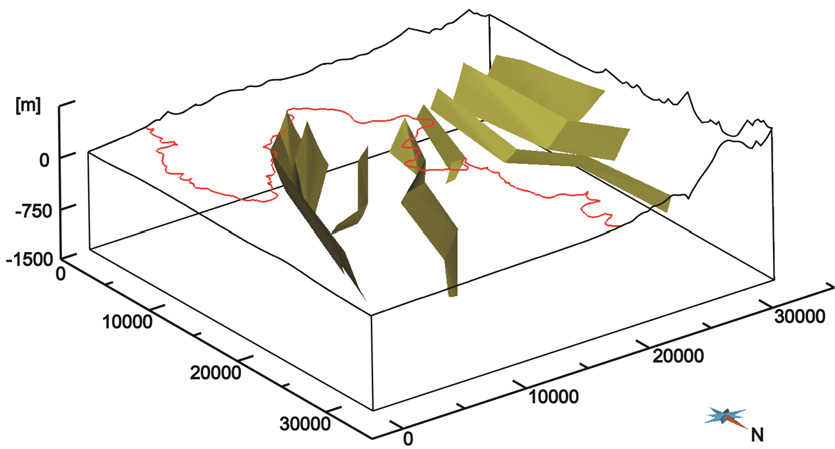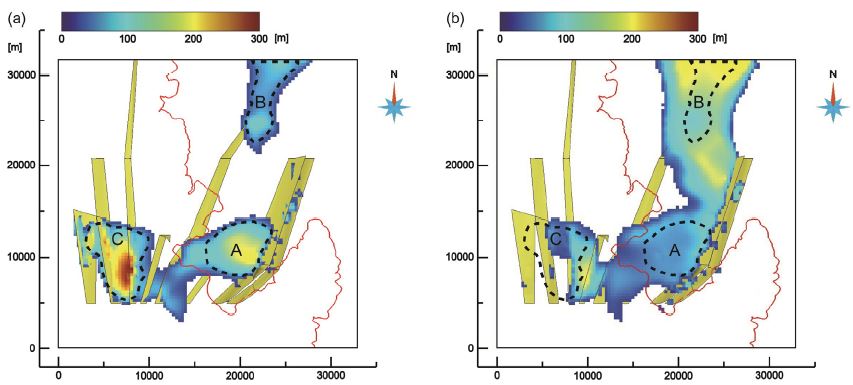
이산화탄소 지중 저장을 위한 한국 포항분지의 삼차원 지질 모델링
초록
이산화탄소 지중 저장을 위한 유망 연안 퇴적분지로 고려되고 있는 한국 포항시와 영일만 일대에 분포하는 포항분지 내 지질 구조 및 지층을 정량적으로 특성화하고 사실적으로 가시화하기 위하여 삼차원 지질 모델링 기술을 이용한 일련의 삼차원 지질 모델링을 수행하였다. 첫 번째로 지표 지질도와 해저 지질 단면도가 반영된 수치 표고 모델(DEM) 및 지질 구조 정보를 포함한 가상 시추공을 사용하여 단층 분포를 예측하는 삼차원 구조 모델링을 불연속 평활 보간법(DSI)을 이용하여 수행하였다. 두 번째로 지표 지질도와 해저 지질 단면도가 반영된 수치 표고 모델 및 지층 정보를 포함한 가상 시추공을 사용하여 지층 경계면 분포를 예측하는 삼차원 층서 모델링을 불연속 평활 보간법을 이용하여 수행하였다. 세 번째로 삼차원 구조 모델의 단층 및 삼차원 층서 모델의 지층 경계면에 기초하여 단층 및 지층 경계면 사이의 공간을 육면체 격자로 이산화하는 삼차원 격자 모델링을 수행하였다. 네 번째로 삼차원 구조 모델, 층서 모델 및 격자 모델을 중합하여 지층 분포를 가시화하는 삼차원 지층 모델링을 수행하였다. 마지막으로 이러한 일련의 삼차원 지질 모델링 결과를 사용하여 포항분지 내 이산화탄소 지중 저장을 위한 저장암과 덮개암 선정, 저장암의 저장 용량 평가 및 주입 위치 제안을 수행하였다. 그 결과 저장암으로는 하성 역암 및 사암층(FCSS)과 천해성 사암층(SMSS)이 선정되었으며, 덮개암으로는 사암 및 이암 교호층(ISMS)과 해성 이암층(MRMS)이 선정되었다. 그리고 이러한 저장암 전체(하성 역암 및 사암층, 천해성 사암층)의 이론 저장 용량은 8,913.65 Mton으로, 유효 저장 용량은 222.84 Mton으로 평가되었다. 또한 저장암의 심도와 두께가 이산화탄소 지중 저장에 유리한 두 군데의 주입 위치가 제안되었다. 이와 같이 본 연구를 통해서 제시된 삼차원 지질 모델링 기술과 결과들은 이산화탄소 지중 저장을 위한 유망 퇴적분지 내 지질 구조 및 지층을 정량적으로 특성화하고 사실적으로 가시화하는 데에 매우 유용하게 활용될 수 있으며, 따라서 향후 이산화탄소 지중 저장 실증 및 상용화 사업 단계에서 부지 선정, 거동 예측, 성능 평가, 주입 운영 설계 및 누출 위험 분석에 실용적인 지침을 제공할 수 있다.
Abstract
A series of three-dimensional geologic modeling is performed using a three-dimensional geologic model to characterize quantitatively and visualize realistically geologic structures and formations in the Pohang Basin, which is considered as a prospective coastal sedimentary basin for geologic storage of carbon dioxide, distributed in Pohang-Si and Yeongil Bay, Korea. First, three-dimensional structural modeling is performed using the digital elevation model (DEM) with the surface geologic map and offshore geologic cross-sections, the virtual boreholes with the geologic structure informations, and the discrete smooth interpolation (DSI) method to predict distributions of faults. Second, three-dimensional stratigraphic modeling is performed using the digital elevation model with the surface geologic map and offshore geologic cross-sections, the virtual boreholes with the geologic formation informations, and the discrete smooth interpolation method to predict distributions of geologic formation boundaries. Third, three-dimensional grid modeling is performed based on the faults of the three-dimensional structural model and the geologic formation boundaries of the three-dimensional stratigraphic model to dicretize spaces between the faults and geologic formation boundaries into hexahedral grids. Fourth, three-dimensional geologic formation modeling is performed polymerizing the three-dimensional structural model, stratigraphic model, and grid model to visualize distributions of geologic formations. Finally, selection of reservoir and cap rocks, evaluation of storage capacities of reservoir rocks, and suggestion of injection locations for geologic storage of carbon dioxide in the Pohang Basin are performed using the results of the series of three-dimensional geologic modeling. As a result, the Fluvial Conglomerate and Sandstone (FCSS) and Shallow Marine Sandstone (SMSS) are selected as reservoir rocks, and the Interlayered Sandstone and Mudstone (ISMS) and Marine Mudstone (MRMS) are selected as cap rocks. The theoretical storage capacity of the whole reservoir rocks (Fluvial Conglomerate and Sandstone, Shallow Marine Sandstone) is evaluated as 8,913.65 Mton, and their effective storage capacity is evaluated as 222.84 Mton. In addition, two different injection locations, where the depth and thickness of the reservoir rocks are favorable for geologic storage of carbon dioxide, are suggested. The three-dimensional geologic modeling technologies and results presented in this study can be very usefully utilized in quantitative characterization and realistic visualization of geologic structures and formations in prospective sedimentary basins for geologic storage of carbon dioxide, and thus hereafter can provide practical guidelines for site selection, behavior prediction, performance evaluation, injection operation design, and leakage risk analysis at the stages of demonstration and commercialization projects of geologic storage of carbon dioxide.
Keywords:
Pohang Basin, characterization, visualization, three-dimensional geologic modeling, geologic storage of carbon dioxide, reservoir rock, cap rock, storage capacity, injection location키워드:
포항분지, 특성화, 가시화, 삼차원 지질 모델링, 이산화탄소 지중 저장, 저장암, 덮개암, 저장 용량, 주입 위치1. 서 론
최근 에너지자원 탐사, 지열 에너지 개발, 방사성 폐기물 지층 처분, 그리고 이산화탄소 지중 저장 등으로 인해 심부 지층에 대한 필요성과 관심이 증대되고 있다. 이러한 심부 지층에 대한 조사 및 연구에서는 지층, 암상 및 물성 분포를 정확하게 파악하는 것이 매우 중요한 과제이다. 따라서 이를 파악하는데 있어서 물리 탐사 보다 더 정확한 방법인 시추 조사에 주로 의존하게 된다. 그러나 비용, 인력 및 시간 등의 문제로 충분한 시추가 이루어지지 못하는 경우가 많이 발생하기 때문에 심부 지질 자료 획득에 한계성을 가진다(Koo et al., 2006). 이와 같은 문제점을 극복하기 위해서 지구통계학적 기법을 통해 심부 지질을 정량적으로 특성화하고 사실적으로 가시화하는 삼차원 지질 모델링(three-dimensional geologic modeling)이 널리 이루어지고 있다. 앞으로 심부 지층에 대한 조사 및 연구에는 이러한 삼차원 지질 모델링 기술을 기반으로 한 다양한 연구들이 선행 또는 병행되어야 한다.
최근 지구통계학적 기법을 이용하여 삼차원 지질 모델링에 대한 다양한 연구들이 수행되어 왔다. 먼저 퇴적분지의 구조 · 층서적인 특성을 분석하기 위해 삼차원 구조 및 층서 모델링이 수행된 바 있다(예, Guyonnet-Benaize et al., 2010; Vilain, 2010). 그리고 퇴적분지의 지형 및 지층 특성 등을 반영하는 삼차원 격자 및 지층 모델링이 수행된 바 있다(예, Gwak and Lee, 2001; Kaufmann and Martin, 2008; Zanchi et al., 2009). 또한 암체의 암상과 물성 및 광체의 품위에 대한 공간적 분포를 예측하고 불확실성을 정량적으로 평가하기 위해 삼차원 암상 및 물성 모델링이 수행된 바 있다(예, Koo and Jeon, 2005; Kim and Park, 2009; de Almeida, 2010; Kim et al., 2010; Jeong and Jang, 2011; Wang and Huang, 2012).
일반적으로 기존의 이산화탄소 지중 저장 프로젝트에서는 저장암의 저장 성능(storage capacity) 및 덮개암의 밀봉 성능(seal capacity)을 극대화하기 위하여 지표면 또는 해수면 기준 최소 800~1000 m 심도에 이산화탄소를 주입하고 있다(Metz et al., 2005). 그러나 이러한 심부의 이산화탄소 지중 저장 시설의 건설과 운영은 깊은 심도와 그에 따른 높은 지질학적 불확실성 때문에 많은 노력과 비용이 소요된다. 이러한 이유로 인해서 심부의 이산화탄소 지중 저장 시설의 건설과 운영 이전에 이산화탄소 지중 저장 대상 퇴적분지의 지질 구조 및 지층을 정량적으로 특성화하고 사실적으로 가시화하는 것이 매우 결정적이다. 한편 국내에서 아직까지 이산화탄소 지중 저장을 위해서 연안 및 해저 퇴적분지(coastal and offshore sedimentary basins)의 삼차원 구조, 층서, 격자 및 지층, 그리고 삼차원 암상 및 물성 모델링을 종합적으로 수행하여 삼차원 지질 모델을 수립하는 연구는 시도된 바가 없다.
본 연구의 일차적인 목적은 삼차원 지질 모델링 기술을 이용하여 최근에 이산화탄소 지중 저장을 위한 유망 연안 퇴적분지로 고려되고 있는 한국 포항시와 영일만 일대에 분포하는 포항분지 내 지질 구조 및 지층을 정량적으로 특성화하고 사실적으로 가시화하는 것이다. 이를 달성하기 위하여 먼저 연구 지역에 대한 수치 지형도, 전자 해도, 지표 지질도 및 지질 구조와 지층 정보를 포함한 해저 지질 단면도와 같은 원시 자료를 수집하여 분석하고 전산화하였으며, 이를 사용하여 삼차원 지질 모델링을 위한 기본적인 전산 입력 자료를 생성하고 전산화하였다. 생성된 전산 입력 자료는 수치 지형도와 전자 해도를 합성하고 지표 지질도와 해저 지질 단면도가 반영된 수치 표고 모델 및 지질 구조와 지층 정보를 포함한 가상 시추공들이다. 그리고 이러한 전산 입력자료를 사용하여 삼차원 구조 모델링, 삼차원 층서 모델링, 삼차원 격자 모델링 및 삼차원 지층 모델링을 순차적으로 수행하였다. 본 연구의 이차적인 목적은 상기한 일련의 삼차원 지질 모델링 결과를 사용하여 포항분지 내 이산화탄소 지중 저장의 적용성을 평가하는 것이다. 이를 달성하기 위하여 먼저 이산화탄소 지중 저장을 위한 저장암 및 덮개암을 선정하였으며, 저장암의 이산화탄소 저장 용량을 평가하였다. 그리고 이산화탄소 주입 위치를 제안하였다.
2. 연구 지역
연구 지역은 한국 경상북도 포항시, 영일만, 호미곶 및 그 주변의 육지와 바다 일대에 해당하는 지역이며, 경 · 위도 상 동경 129°07’55”~129°41’18”와 북위 35° 52’10”~36°20’29”에 위치하고 있다(그림 1). 지질학적으로 연안 퇴적분지인 포항분지가 대부분을 차지하는 연구 지역의 지질은 전반적으로 쥐라기 화성암류(대보관입암류)와 백악기 퇴적암류(신동층군, 하양층군) 및 화성암류(유천층군, 불국사관입암류)를 기반암으로 하여 제3기(고신생기) 화성암류, 제3기 (신신생기) 퇴적암류(장기층군, 연일층군) 및 제4기 충적층으로 구성되어 있다(Um et al., 1964; Sohn et al., 2001; Sohn and Son, 2004; Yoon 2013) (그림 1). 특히 Yoon (2013)은 연구 지역의 해저 지질을 하부로부터 백악기 기반암 및 제3기 화산암류(Cretaceous Basement and Tertiary Volcanics, CBTV), 장기층군(Janggi Group)에 해당하는 일차 및 재동 화산암류 (Primary and Resedimented Volcanics, PRSV), 그리고 연일층군(Yeonil Group)에 해당하는 하성 역암 및 사암층(Fluvial Conglomerate and Sandstone, FCSS), 천해성 사암층(Shallow Marine Sandstone, SMSS), 사암 및 이암 교호층(Interlayered Sandstone and Mudstone, ISMS), 해성 이암층(Marine Mudstone, MRMS)으로 구분하였다(그림 2). 한편 연구 지역의 육상 및 해저에는 양산단층계(Yangsan Fault System) 및 오천단층계(Ocheon Fault System)가 발달하고 있다(Lee et al., 1999; Cheon et al., 2012). 이러한 포항분지는 최근에 지열 에너지 개발 및 이산화탄소 지중 저장 등으로 주목받고 있는 퇴적분지이다.
3. 삼차원 지질 모델링 개요
3.1 삼차원 지질 모델
본 연구에서 삼차원 지질 모델링에 이용된 프로그램은 GOCAD Research Group에서 개발한 GOCAD(Geological Object Computer Aided Design) (Paradigm, 2012)로서 지질 구조 해석이나 격자 모델 생성 및 물성 분포 시뮬레이션, 그리고 탄성파 탐사 자료 해석 등 다양한 기능을 제공하는 삼차원 지질 모델링 소프트웨어이다. 이 소프트웨어는 에너지자원 탐사, 지열 에너지 개발, 방사성 폐기물 지층 처분, 그리고 이산화탄소 지중 저장 등의 매우 다양한 분야에서 활용되고 있다.
3.2 삼차원 지질 모델링 작업흐름도
본 연구를 통해서 수행하고자 하는 삼차원 지질 모델링의 개념을 좀 더 명확하게 정립하기 위해서 작업흐름도로 그 방법론을 정의하였다(그림 3). 먼저 연구 지역에 대한 수치 지형도와 전자 해도(그림 3a), 지표 지질도(그림 3b) 및 지질 구조(단층)와 지층 정보를 포함한 해저 지질 단면도(그림 3c)와 같은 원시 자료를 수집하여 분석하고 전산화하며, 이를 사용하여 삼차원 지질 모델링을 위한 기본적인 전산 입력 자료를 생성하고 전산화한다. 생성된 전산 입력 자료는 수치 지형도와 전자 해도를 합성하고 지표 지질도와 해저 지질 단면도가 반영된 수치 표고 모델(그림 3d) 및 지질 구조(단층)와 지층 정보를 포함한 가상 시추공들(그림 3e)이다. 그리고 이러한 전산 입력 자료를 사용하여 삼차원 구조 모델링(그림 3f), 삼차원 층서 모델링(그림 3g), 삼차원 격자 모델링(그림 3h) 및 삼차원 지층 모델링(그림 3i)을 순차적으로 수행한다.
3.3 삼차원 지질 모델링 영역
본 연구에서는 신뢰도 높은 삼차원 지질 모델링을 수행하기 위하여 상기한 6개의 해저 지질 단면도(그림 2)가 밀집되어 있는 동서 32,600 m, 남북 31,800 m, 그리고 해수면 기준 심도 1,500 m 영역을 삼차원지질 모델링 영역(geologic modeling domain)으로 설정하였다. 이러한 삼차원 지질 모델링 영역은 경·위도 상 동경 129°15’15”~129°37’47”와 북위 35°56’47”~36°15’09”에 위치하고 있으며(그림 1, 2), 수치 지형도와 전자 해도를 합성한 수치 표고 모델을 포함하고 있다(그림 4a).
3.4 원시 자료 분석 및 전산화
먼저 연구 지역에 대한 수치 지형도(National Geographic Information Institute, 2013) (그림 4a), 전자 해도(Korea Hydrographic and Oceanographic Adminstration, 2011) (그림 4a), 지표 지질도(Um et al., 1964; Sohn et al., 2001; Sohn and Son, 2004) (그림 4b) 및 6개의 해저 지질 단면도(Yoon, 2013) (그림 4c)와 같은 원시 자료를 수집하여 분석하고 전산화하였다. 그리고 해저 지질 구조(단층)와 지층의 전반적인 분포를 파악하기 위하여 6개의 해저 지질 단면도로부터 추정된 지질 구조(단층)와 지층 정보를 가지는 일련의 가상 시추공(그림 4d)을 생성하고 전산화하였다. 이러한 가상 시추공은 삼차원 지질 모델링 영역(그림 4a) 내에서 해저 지질 단면도를 따라서 해저 지질 단면도의 교차선을 모두 포함하면서 해저 지질 단면도의 정보를 누락하지 않을 정도의 376.2~380.8 m 간격 범위로 총 464개가 생성되었다(그림 4d).
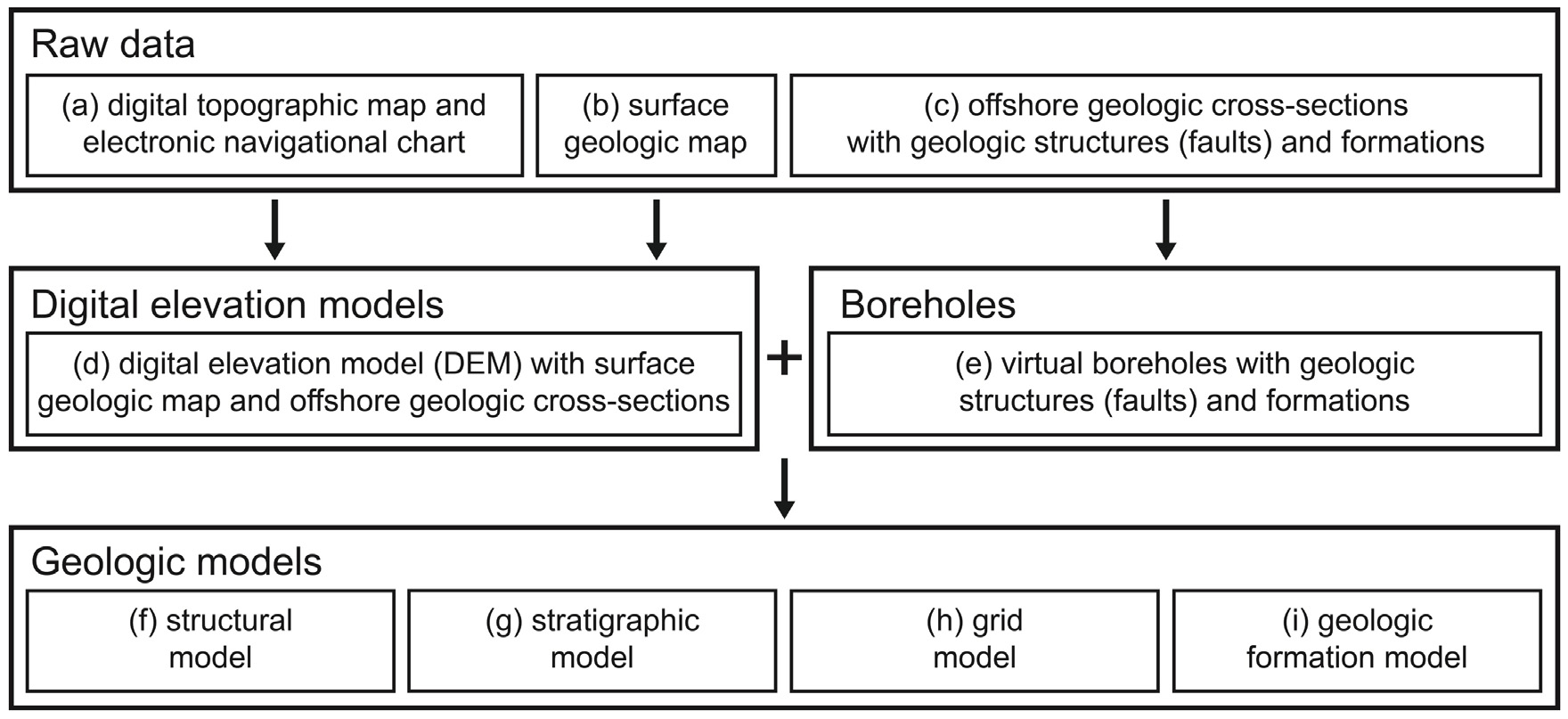
Work flow chart of three-dimensional geologic modeling of the Pohang Basin through (a) digital topographic map and electronic navigational chart, (b) surface geologic map, (c) offshore geologic cross-sections with geologic structures (faults) and formations, (d) digital elevation model (DEM) with surface geologic map and offshore geologic cross-sections, (e) virtual boreholes with geologic structures (faults) and formations, (f) structural model, (g) stratigraphic model, (h) grid model, and (i) geologic formation model.

Three-dimensional spatial distributions of (a) geologic modeling domain with digital elevation model, (b) surface geologic map, (c) 6 offshore geologic cross-sections with geologic structures (faults) and formations, and (d) 464 virtual boreholes with geologic structures (faults) and formations in the Pohang Basin.
4. 삼차원 지질 모델링 결과
4.1 삼차원 구조 모델링
삼차원 구조 모델링에서는 앞서 수행된 원시 자료 분석 및 전산화를 통해 얻은 지표 지질도(그림 4b)와 해저 지질 단면도(그림 4c)가 반영된 수치 표고 모델(그림 4a) 및 지질 구조(단층) 정보를 포함한 464개의 가상 시추공(그림 4d)이 각각 지표면과 해저면 및 지하에서의 단층선으로 사용되었다. 이와 같은 수치 표고 모델 및 464개의 가상 시추공으로부터 삼차원 지질 모델링 영역 전체에서 단층 분포를 예측하는 삼차원 구조 모델링을 불연속 평활 보간법(discrete smooth interpolation, DSI method) (Mallet, 1989)을 이용하여 수행하였으며, 그 결과는 그림 5와 같다. 그림 5에서 보다시피 생성된 삼차원 구조 모델은 양산단층계 및 오천단층계에 해당하는 8개의 주요 단층으로 구성되어 있다. 이러한 8개의 주요 단층은 연구 지역의 육상 및 해저에서 지층들을 절단하고(dissecting) 변위시키고(offsetting) 있다.
4.2 삼차원 층서 모델링
삼차원 층서 모델링에서는 앞서 수행된 원시 자료 분석 및 전산화를 통해 얻은 지표 지질도(그림 4b)와 해저 지질 단면도(그림 4c)가 반영된 수치 표고 모델(그림 4a) 및 지층 정보를 포함한 464개의 가상 시추공(그림 4b)이 각각 지표면과 해저면 및 지하에서의 지층 경계면으로 사용되었다. 이와 같은 수치 표고 모델 및 464개의 가상 시추공으로부터 삼차원 지질 모델링 영역 전체에서 지층 경계면 분포를 예측하는 삼차원 층서 모델링을 불연속 평활 보간법(Mallet, 1989)을 이용하여 수행하였으며, 그 결과는 그림 6과 같다. 그림 6에서 보다시피 생성된 삼차원 층서 모델은 하부로부터 백악기 기반암 및 제3기 화산암류(CBTV) 상부면(그림 6a), 장기층군에 해당하는 일차 및 재동화산암류(PRSV) 상부면(그림 6b), 그리고 연일층군에 해당하는 하성 역암 및 사암층(FCSS) 상부면(그림 6c), 천해성 사암층(SMSS) 상부면(그림 6d), 사암 및 이암 교호층(ISMS) 상부면(그림 6e), 해성 이암층(MRMS) 상부면(그림 6f) 총 6개의 지층 경계면으로 구성되어 있다. 또한 그림 6에서 보다시피 삼차원 지질 모델링 영역 북동부 지역에서 해수면을 기준으로 백악기 기반암 및 제3기 화산암류 상부면 심도는 1,175 m, 일차 및 재동 화산암류 상부면 심도는 1,025 m, 하성 역암 및 사암층 상부면 심도는 959 m, 천해성 사암층 상부면 심도는 771 m, 사암 및 이암 교호층 상부면 심도는 451 m, 그리고 해성 이암층 상부면 심도는 69 m이다.
4.3 삼차원 격자 모델링
상기한 삼차원 구조 모델의 단층 및 삼차원 층서 모델의 지층 경계면에 기초하여 단층 및 지층 경계면 사이의 공간을 육면체 격자로 이산화하는 삼차원 격자 모델링을 수행하였으며, 그 결과는 그림 7과 같다. 그림 7에서 보다시피 생성된 삼차원 격자 모델은 동서 방향으로 100개, 남북 방향으로 100개, 수직 방향으로 26개로 총 260,000개의 육면체 격자로 이산화되어 있다. 특히 삼차원 층서 모델링을 통해 생성된 지층 상부면 중 기반암 상부면과 만나는 다른 지층 상부면 주변에서 육면체 격자가 세밀하게 제작되었으며, 인접한 두 지층 상부면의 간격이 좁아지는 부분에서도 육면체 격자가 세밀하게 제작되었다. 그리고 생성된 삼차원 격자 모델은 삼차원 구조 모델을 통해 생성된 총 8개의 주요 단층 및 삼차원 층서 모델링을 통해 생성된 총 6개의 지층 상부면을 경계로 총 6개의 지층 구역(block)으로 분리되어 있다. 한편 삼차원 지질 모델링 영역 내에서 이들 6개의 지층 구역별 격자의 수는 표 1에 정리되어 있다.
4.4 삼차원 지층 모델링
상기한 삼차원 구조 모델, 층서 모델 및 격자 모델을 중합하여 지층 분포를 가시화하는 삼차원 지층 모델링을 수행하였으며, 그 결과는 그림 8과 같다. 그림 8에서 보다시피 생성된 삼차원 지층 모델은 하부로부터 백악기 기반암 및 제3기 화산암류(CBTV) (그림 8a), 장기층군에 해당하는 일차 및 재동 화산암류(PRSV) (그림 8b), 그리고 연일층군에 해당하는 하성 역암 및 사암층(FCSS) (그림 8c), 천해성 사암층(SMSS) (그림 8d), 사암 및 이암 교호층(ISMS) (그림 8e), 해성 이암층(MRMS) (그림 8f) 순으로 총 6개의 지층으로 구성되어 있다. 또한 그림 8에서 보다시피 삼차원 지질 모델링 영역 북동부 지역에서 일차 및 재동 화산암류 두께는 150 m, 하성 역암 및 사암층 두께는 66 m, 천해성 사암층 두께는 188 m, 사암 및 이암 교호층 두께는 320 m, 그리고 해성 이암층 두께는 382 m이다. 한편 삼차원 지질 모델링 영역 내에서 이들 6개의 지층 구역별 체적 및 체적 비율은 표 1에 정리되어 있다. 표 1에서 보다시피 연일층군에 해당하는 4개의 지층들 중에서는 사암 및 이암 교호층이 가장 많이 분포하며, 하성 역암 및 사암층이 가장 적게 분포한다.
5. 이산화탄소 지중 저장 적용성 평가
상기한 일련의 삼차원 지질 모델링 결과를 사용하여 포항분지 내 이산화탄소 지중 저장을 위한 저장암 및 덮개암 선정, 저장암의 저장 용량 평가 및 주입 위치 제안을 수행하였다.
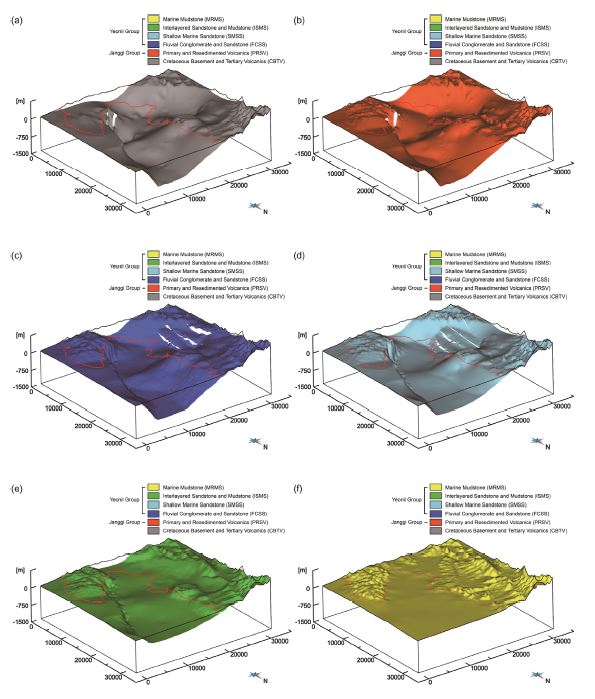
Three-dimensional stratigraphic model of the Pohang Basin with upper surfaces of (a) Cretaceous Basement and Tertiary Volcanics (CBTV), (b) Primary and Resedimented Volcanics (PRSV), (c) Fluvial Conglomerate and Sandstone (FCSS), (d) Shallow Marine Sandstone (SMSS), (e) Interlayered Sandstone and Mudstone (ISMS), and (f) Marine Mudstone (MRMS) using discrete smooth interpolation (DSI) method.

Three-dimensional grid model of the Pohang Basin with boundaries of Cretaceous Basement and Tertiary Volcanics (CBTV), Primary and Resedimented Volcanics (PRSV), Fluvial Conglomerate and Sandstone (FCSS), Shallow Marine Sandstone (SMSS), Interlayered Sandstone and Mudstone (ISMS), and Marine Mudstone (MRMS).
5.1 이산화탄소 저장암 및 덮개암 선정
상기한 일련의 삼차원 지질 모델링 결과를 분석하여 연일층군에 해당하는 4개의 지층들 중에서 이산화탄소 지중 저장을 위한 저장암으로는 상대적으로 하부에 위치하고 사암이 우세한 투수성의 대염수층(saline aquifer or formation)인 하성 역암 및 사암층(FCSS)과 천해성 사암층(SMSS)이 선정되었으며, 덮개암으로는 상대적으로 상부에 위치하고 이암이 우세한 불투수성의 준대염수층(saline aquitard or confining layer)인 사암 및 이암 교호층(ISMS)과 해성 이암층(MRMS)이 선정되었다. 그리고 그 결과는 표 1에 정리되어 있다. 표 1에서 보다시피 저장암 전체(하성 역암 및 사암층, 천해성 사암층)의 체적은 4.41 × 1010 m3이며, 덮개암 전체(사암 및 이암 교호층, 해성 이암층)의 체적은 3.00 × 1011 m3이다.
5.2 이산화탄소 저장 용량 평가
상기한 바와 같이 저장암으로 선정된 대염수층인 하성 역암 및 사암층(FCSS)과 천해성 사암층(SMSS)에 수리동역학적으로 포획(hydrodynamic trapping)되는 자유 유체상(free fluid phase) 이산화탄소의 이론 또는 잠재 저장 용량(theoretical or potential storage capacity) (M) 및 유효 또는 실재 저장 용량(effective or realistic storage capacity) (M)을 평가하기 위하여 다음과 같은 체적 기반의 이산화탄소 지중 저장 용량 평가 방법인 NETL 방법(National Energy Technology Laboratory, 2007, 2008, 2010, 2012)을 이용하였다.
| (1) |
| (2) |
여기에서 V 는 대상 대염수층의 전체 체적(total volume) (L3), n은 대상 대염수층의 공극률(porosity) (L3/L3), ρCO2는 대상 대염수층 내 저장 조건(본 연구에서는 지층의 중간 심도)을 대표하는 압력 및 온도에 해당하는 이산화탄소의 밀도(density) (M/L3), 그리고 E는 대상 대염수층의 공극 체적(pore volume) (L3) Vn 중에서 이산화탄소에 의해 채워지는 비율을 나타내는 이산화탄소 저장 효율 계수(storage efficiency factor) (L3/L3) (0 ≤ E ≤ 1)이다.
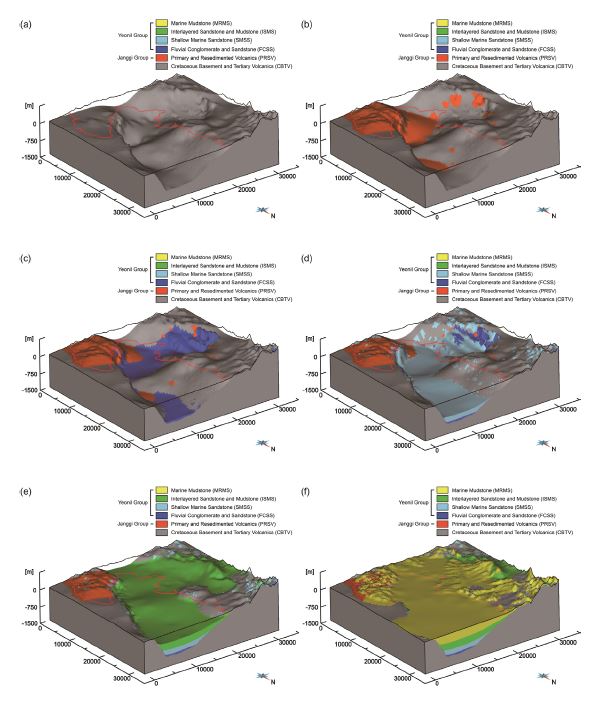
Three-dimensional geologic formation model of the Pohang Basin with (a) Cretaceous Basement and Tertiary Volcanics (CBTV), (b) Primary and Resedimented Volcanics (PRSV), (c) Fluvial Conglomerate and Sandstone (FCSS), (d) Shallow Marine Sandstone (SMSS), (e) Interlayered Sandstone and Mudstone (ISMS), and (f) Marine Mudstone (MRMS).
본 연구에서 사용된 하성 역암 및 사암층과 천해성 사암층의 공극률(porosity)은 각각 0.36 및 0.24이며(Domenico, and Schwartz, 1990), 이산화탄소 저장 효율 계수(storage efficiency factor)는 0.025이다(National Energy Technology Laboratory, 2007). 또한 대상 대염수층 내 저장 조건을 대표하는 압력 계산에는 해수 염도(seawater salinity) 35,000 ppm에 해당하는 해수 밀도(seawater density) 1,025 kg/m3, 해수면 기준 정수압 조건(hydrostatic condition), 대기압(atmospheric pressure) 101,325 Pa (1 atm) 및 중력가속도(gravitational acceleration) 9.81 m/sec2이 사용되었으며, 온도 계산에는 수심 50 m에 해당하는 해저면 온도(seafloor temperature) 11.0℃ (Na et al., 1991) 및 지온 경사(geothermal gradient) 26.04℃/km (Estimate 48) (Kim and Lee, 2007)가 사용되었다. 주어진 압력, 온도 및 해수 염도 조건에서의 이산화탄소의 밀도는 Spycher and Pruess (2005)가 제안한 상태방정식(equation of state, EOS) 자료로부터 계산되었다. 상기한 방법을 이용해서 평가된 하성 역암 및 사암층과 천해성 사암층의 (자유 유체상) 이산화탄소 이론 및 유효 저장 용량은 표 2에 정리되어 있다. 표 2에서 보다시피 저장암 전체(하성 역암 및 사암층, 천해성 사암층)의 이산화탄소 이론 저장 용량은 8,913.65 Mton으로, 이산화탄소 유효 저장 용량은 222.84 Mton으로 평가되었다. 한편 표 2에서 보다시피 두 저장암 중에서 천해성 사암층의 체적이 하성 역암 및 사암층의 체적의 약 1.59배이지만 그 이산화탄소 이론 및 유효 저장 용량은 약 1.06배에 불과하다. 이는 상기한 바와 같이 하성 역암 및 사암층의 공극률이 천해성 사암층의 공극률의 1.5배이기 때문이다. 따라서 두 저장암 중에서는 상대적으로 하부에 위치하고 공극률이 높은 하성 역암 및 사암층(FCSS)이 이산화탄소 지중 저장에 더 바람직하다.
5.3 이산화탄소 주입 위치 제안
상기한 바와 같이 저장암으로 선정되고 이산화탄소 저장 용량이 평가된 대염수층인 하성 역암 및 사암층(FCSS)과 천해성 사암층(SMSS)의 공간적 분포, 그리고 지질 구조(단층)와의 공간적 상관 관계를 분석하여 저장암의 심도와 두께가 이산화탄소 지중 저장에 유리한 두 군데의 이산화탄소 주입 위치가 제안되었으며, 그 결과는 그림 9와 같다. 그림 9에서 보다시피 제안된 이산화탄소 주입 위치는 영일만 지역(지역 A) 및 포항분지 북동부 지역(지역 B)이다. 하지만 영일만 지역(지역 A)에 분포하는 저장암에 지중 주입된 이산화탄소는 자유 유체상으로 덮개암 하부면을 따라서 인근 육상인 포항시 쪽으로 이동 및 누출할 수 있는 것으로 판단된다. 또한 영일만 지역(지역 A)에 분포하는 저장암보다 포항분지 북동부 지역(지역 B)에 분포하는 저장암의 체적 및 이산화탄소 저장 용량이 더 크다. 따라서 비용 및 시간 측면에서는 포항시에서 가까운 영일만 지역(지역 A)에 중·소규모 이산화탄소 지중 주입이 타당하지만 무결성 및 안전성 측면에서는 포항시에서 먼 포항분지 북동부 지역(지역 B)에 대·중규모 이산화탄소 지중 주입이 타당하다. 한편 포항시 서부 지역(지역 C)에 분포하는 저장암은 그 두께는 두껍지만 그 심도가 상대적으로 얕고 주요 단층에 의해서 절개되고 갈라져 있기 때문에 이산화탄소 지중 저장에 적합하지 않은 것으로 판단된다.
6. 결 론
이산화탄소 지중 저장을 위한 유망 연안 퇴적분지로 고려되고 있는 한국 포항시와 영일만 일대에 분포하는 포항분지 내 지질 구조 및 지층을 정량적으로 특성화하고 사실적으로 가시화하기 위하여 삼차원 지질 모델링 기술을 이용한 일련의 삼차원 지질 모델링을 수행하였다. 이를 달성하기 위하여 먼저 연구 지역에 대한 수치 지형도, 전자 해도, 지표 지질도 및 지질 구조와 지층 정보를 포함한 해저 지질 단면도와 같은 원시 자료를 수집하여 분석하고 전산화하였으며, 이를 사용하여 삼차원 지질 모델링을 위한 기본적인 전산 입력 자료를 생성하고 전산화하였다. 생성된 전산 입력 자료는 수치 지형도와 전자 해도를 합성하고 지표 지질도와 해저 지질 단면도가 반영된 수치 표고 모델 및 지질 구조와 지층 정보를 포함한 가상 시추공들이다. 그리고 이러한 전산 입력 자료를 사용하여 삼차원 구조 모델링, 삼차원 층서 모델링, 삼차원 격자 모델링 및 삼차원 지층 모델링을 순차적으로 수행하였다. 첫 번째로 지표 지질도와 해저 지질 단면도가 반영된 수치 표고 모델 및 지질 구조 정보를 포함한 가상 시추공을 사용하여 단층 분포를 예측하는 삼차원 구조 모델링을 불연속 평활 보간법을 이용하여 수행하였다. 이렇게 생성된 삼차원 구조 모델은 8개의 주요 단층으로 구성되어 있다. 두 번째로 지표 지질도와 해저 지질 단면도가 반영된 수치 표고 모델 및 지층 정보를 포함한 가상 시추공을 사용하여 지층 경계면 분포를 예측하는 삼차원 층서 모델링을 불연속 평활 보간법을 이용하여 수행하였다. 이렇게 생성된 삼차원 층서 모델은 총 6개의 지층 경계면으로 구성되어 있다. 세번째로 삼차원 구조 모델의 단층 및 삼차원 층서 모델의 지층 경계면에 기초하여 단층 및 지층 경계면 사이의 공간을 육면체 격자로 이산화하는 삼차원 격자 모델링을 수행하였다. 이렇게 생성된 삼차원 격자 모델은 총 260,000개의 육면체 격자로 이산화되어 있다. 네 번째로 삼차원 구조 모델, 층서 모델 및 격자 모델을 중합하여 지층 분포를 가시화하는 삼차원 지층 모델링을 수행하였다. 이렇게 생성된 삼차원 지층 모델은 총 6개의 지층으로 구성되어 있다. 마지막으로 이러한 일련의 삼차원 지질 모델링 결과를 사용하여 포항분지 내 이산화탄소 지중 저장을 위한 저장암과 덮개암 선정, 저장암의 저장 용량 평가 및 주입 위치 제안을 수행하였다. 그 결과 저장암으로는 하성 역암 및 사암층(FCSS)과 천해성 사암층(SMSS)이 선정되었으며, 덮개암으로는 사암 및 이암 교호층(ISMS)과 해성 이암층(MRMS)이 선정되었다. 이렇게 선정된 저장암 전체(하성 역암 및 사암층, 천해성 사암층)의 체적은 4.41 × 1010 m3이며, 덮개암 전체(사암 및 이암 교호층, 해성 이암층)의 체적은 3.00 × 1011 m3이다. 그리고 이러한 저장암 전체(하성 역암 및 사암층, 천해성 사암층)의 이론저장 용량은 8,913.65 Mton으로, 유효 저장 용량은 222.84 Mton으로 평가되었다. 이렇게 평가된 두 저장암의 이론 및 유효 저장 용량이 각각 거의 동일하므로 두 저장암 중에서는 상대적으로 하부에 위치하고 공극률이 높은 하성 역암 및 사암층(FCSS)이 이산화탄소 지중 저장에 더 바람직하다. 또한 저장암의 심도와 두께가 이산화탄소 지중 저장에 유리한 두 군데의 주입 위치가 제안되었다. 이렇게 제안된 주입 위치는 영일만 지역 및 포항분지 북동부 지역이다. 이와 같이 본 연구를 통해서 제시된 삼차원 지질 모델링 기술과 결과들은 이산화탄소 지중 저장을 위한 유망 퇴적분지 내 지질 구조 및 지층을 정량적으로 특성화하고 사실적으로 가시화하는 데에 매우 유용하게 활용될 수 있으며, 따라서 향후 이산화탄소 지중 저장 실증 및 상용화 사업 단계에서 부지 선정, 거동 예측, 성능 평가, 주입 운영 설계 및 누출 위험 분석에 실용적인 지침을 제공할 수 있다.
Acknowledgments
본 연구는 산업통상자원부 산하 한국에너지기술평가원의 에너지자원융합원천기술개발사업 연구비 지원에 의해 수행되었습니다. 본 연구는 또한 부분적으로 미래창조과학부 산하 한국연구재단의 Brain Korea 21 사업 지원에 의해 수행되었습니다. 아울러 본 논문의 심사 과정에서 발전적인 조언과 비판을 해주신 익명의 두 심사자님께 깊은 감사를 드립니다.
REFERENCES
-
Cheon, Y., Son, M., Song, C.W., Kim, J.S., and Sohn, Y.K., (2012), Geometry and kinematics of the Ocheon Fault System along the boundary between the Miocene Pohang and Janggi basins, SE Korea, and its tectonic implications, Geosciences Journal, 16, p253-273.
[https://doi.org/10.1007/s12303-012-0029-0]

-
de Almeida, J.A., (2010), Stochastic simulation methods for characterization of lithoclasses in carbonate reservoirs, Earth-Science Reviews, 101, p250-270.
[https://doi.org/10.1016/j.earscirev.2010.05.002]

- Domenico, P.A., and Schwartz, F.W., (1990), Physical and Chemical Hydrogeology, John Wiley and Sons, New York, USA, p824.
-
Guyonnet-Benaize, C., Lamarche, J., Masse, J.P., Villeneuve, M., and Viseur, S., (2010), 3D structural modelling of small-deformations in poly-phase fault pattern: Application to the Mid-Cretaceous Durance uplift, Provence (SE France), Journal of Geodynamics, 50, p81-93.
[https://doi.org/10.1016/j.jog.2010.03.003]

- Gwak, S.H., and Lee, D.S., (2001), 3-D visualization of reservoir characteristics through GOCAD, Geophysics and Geophysical Exploration, 4, p80-83, (in Korean with English abstract).
-
Jeong, J., and Jang, W.I., (2011), Estimation of distribution of the weak soil layer for using geostatistics, Journal of the Korean Society of Marine Engineering, 35, p1132-1140, (in Korean with English abstract).
[https://doi.org/10.5916/jkosme.2011.35.8.1132]

-
Kaufmann, O., and Martin, T., (2008), 3D geological modelling from boreholes, cross-sections and geological maps, application over former natural gas storages in coal mines, Computers and Geosciences, 34, p278-290, (reprinted in 2009, 35, 70-82).
[https://doi.org/10.1016/j.cageo.2007.09.005]

- Kim, D.H., Ryu, D.W., Lee, J.H., Choi, I.G., Kim, J.K., and Lee, W.J., (2010), Comparative studies of kriging methods for estimation of geo-layer distribution of Songdo International City in Incheon, Journal of the Korean Geotechnical Society, 26, p57-64, (in Korean with English abstract).
-
Kim, H.C., and Lee, Y, (2007), Heat flow in the Republic of Korea, Journal of Geophysical Research, 112, pB05413.
[https://doi.org/10.1029/2006JB004266]

- Kim, S., and Park, H.D., (2009), Development of software for mineral resource estimation and 3D modeling using variogram, Journal of the Korean Society of Mineral and Energy Resources Engineers, 46, p151-159, (in Korean with English abstract).
- Koo, C.M., Hong, C.W., and Jeon, S.W., (2006), Estimation of rock mass rating (RMR) and assessment of its uncertainty using conditional simulations, Tunnel and Underground Space, Journal of the Korean Society for Rock Mechanics, 16, p135-145, (in Korean with English abstract).
- Koo, C.M., and Jeon, S.W., (2005), Using conditional simulation to estimate rock mass properties and assess the uncertainty, Proceedings of the Korean Society for Rock Mechanics Spring Conference, Seoul, Korea, March 31, p81-95, (in Korean).
- Korea Hydrographic and Oceanographic Adminstration, (2011), Electronic navigational chart of Pohang Harbor Vicinity sheet, Scale 1:75,000, Sheet 175, Korea Hydrographic and Oceanographic Adminstration (KHOA), Busan, Korea, 1 sheet, (DXF file).
- Lee, B.J., Choi, S.J., Chwae, U.C., and Ryoo, C.R., (1999), Characteristics of the Quaternary faulting of the Wolpyeong, Yangsan, S.E. Korea, Journal of the Geological Society of Korea, 35, p179-188, (in Korean with English abstract).
-
Mallet, J.L., (1989), Discrete smooth interpolation, Association for Computing Machinery (ACM) Transactions on Graphics (TOG), 8, p121-144.
[https://doi.org/10.1145/62054.62057]

- Metz, B., Davidson, O., de Coninck, H.C., Loos, M., and Mayer, L.A. (eds.), (2005), Intergovernmental Panel on Climate Change Special Report on Carbon Dioxide Capture and Storage, Cambridge University Press, Cambridge, UK, p431.
- Na, J.Y., Lee, S.W., and Cho, K.D., (1991), A study on sea water and ocean current in the sea adjacent to Korea Peninsula, The vertical structure of temperatures in the East Sea of Korea, Bulletin of the Korean Fishery Society, 24, p215-228, (in Korean with English abstract).
- National Energy Technology Laboratory, (2007), Carbon Sequestration Atlas of the United States and Canada, National Energy Technology Laboratory (NETL), Pittsburgh, Pennsylvania, USA, p86.
- National Energy Technology Laboratory, (2008), Carbon Sequestration Atlas of the United States and Canada, Second Edition, National Energy Technology Laboratory (NETL), Pittsburgh, Pennsylvania, USA, p136.
- National Energy Technology Laboratory, (2010), Carbon Sequestration Atlas of the United States and Canada, Third Edition, National Energy Technology Laboratory (NETL), Pittsburgh, Pennsylvania, USA, p160.
- National Energy Technology Laboratory, (2012), The United States Carbon Utilization and Storage Atlas, Fourth Edition, National Energy Technology Laboratory (NETL), Pittsburgh, Pennsylvania, USA, p129.
- National Geographic Information Institute, (2013), Digital topographic maps of Cheongha, Chilpo, Pohang, Hwanho, Daebo, Yeonil, Yongdeok, and Guryongpo sheets, Scale 1:25,000, Sheets 369141, 369142, 369143, 369144, 369153, 359021, 359022, and 359031, National Geographic Information Institute (NGII), Suwon, Korea, 8 sheets, (DXF file).
- Paradigm, (2012), GOCAD user guide, Manual Paradigm, Houston, Texas, USA, pvarious pages.
-
Sohn, Y.K., Rhee, C.W., and Shon, H., (2001), Revised stratigraphy and reinterpretation of the Miocene Pohang basinfill, SE Korea: Sequence development in response to tectonism and eustasy in a back-arc basin margin, Sedimentary Geology, 143, p265-285.
[https://doi.org/10.1016/S0037-0738(01)00100-2]

-
Sohn, Y.K., and Son, M., (2004), Synrift stratigraphic geometry in a transfer zone coarse-grained delta complex, Miocene Pohang Basin, SE Korea, Sedimentology, 51, p1387-1408.
[https://doi.org/10.1111/j.1365-3091.2004.00679.x]

-
Spycher, N., and Pruess, K., (2005), CO2-H2O mixtures in the geological sequestration of CO2, II. Partitioning in chloride brines at 12-100℃ and up to 600 bar, Geochimica et Cosmochimica Acta, 69, p3309-3320.
[https://doi.org/10.1016/j.gca.2005.01.015]

- Um., S.H., Lee, D.W., and Bak, B.S., (1964), Explanatory text of the geological map of Pohang sheet, Scale 1:50,000, Technical Report Sheet-7022-II, Geological Survey of Korea (GSK), Seoul, Korea, p37, 1 map sheet, (in Korean and English).
- Vilain, D., (2010), 3D modelling and restoration of the Vargfors Basin, Certral Skellefte District, Northern Sweden, using gOcad and MOVE software, M.S. Thesis, Lulea University of Technology, Lulea, Sweden, p19.
-
Wang, G., and Huang, L., (2012), 3D geological modeling for mineral resource assessment of the Tongshan Cu deposit, Heilongjiang Province, China, Geoscience Frontiers, 3, p483-491.
[https://doi.org/10.1016/j.gsf.2011.12.012]

- Yoon, S.H., (2013), Offshore geologic cross-sections of the Pohang Basin, Korea, Unpublished Data, Jeju National University (JNU), Jeju, Korea, 6 sheets, (in English).
-
Zanchi, A., Francesca, S., Stefano, Z., Simone, S., and Graziano, G., (2009), 3D reconstruction of complex geological bodies: Examples from the Alps, Computers and Geosciences, 35, p49-69.
[https://doi.org/10.1016/j.cageo.2007.09.003]

